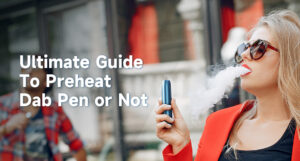Table of Contents
Dabbing has become a popular method for consuming cannabis concentrates in recent years, offering a potent and flavorful experience for enthusiasts. However, to fully appreciate the benefits of dabbing, it’s crucial to understand the importance of temperature control. Finding the ideal temperature for dabbing is a delicate balance that can significantly impact your overall experience. In this blog, we’ll explore the science behind dabbing temperatures, the factors that influence your choice, and how to achieve the perfect dabbing temperature for your preferences.
What is the ideal temperature for dabbing?
The ideal temperature for dabbing varies from person to person and depends on individual preferences, the type of concentrate being used, and the effects you’re seeking. There is no one-size-fits-all answer, but here’s a general guideline:
- Low-Temperature Dabs
Also known as “terpene preservation” dabs, these are typically taken at temperatures between 300°F to 400°F (149°C to 204°C). Low-temperature dabs offer the best preservation of the terpene profile, providing an array of flavors and a smoother, less harsh hit.
Pros:
Flavor Preservation: Low-temperature dabbing preserves the terpenes and aromatic compounds in the concentrate, resulting in a rich and flavorful experience.
Smooth Hits: Lower temperatures produce smoother and less harsh hits, which can be easier on the throat and lungs.
Balanced Effects: It offers a balanced combination of cannabinoids and terpenes, providing both flavor and a milder high.
Cons:
Slower Vaporization: Vaporizing at lower temperatures may require more time to fully consume the concentrate, leading to a longer dabbing process.
Less Intense High: If you prefer an intense, immediate high, low-temperature dabbing might not provide the desired effects.
- Medium-Temperature Dabs
This range falls between 400°F to 600°F (204°C to 316°C). Medium-temperature dabs offer a balance between preserving flavor and delivering a robust cannabinoid experience. It’s a popular choice for those who want both flavor and potency.
Pros:
Balanced Experience: Mid-temperature dabbing offers a balance between flavor and potency, making it versatile for various preferences.
Efficient Vaporization: Concentrates vaporize more quickly than at low temperatures, making for a faster dabbing process.
Wider Range of Effects: A broader spectrum of cannabinoids and terpenes are activated, allowing for a range of effects.
Cons:
Potential Loss of Terpenes: While mid-temperature dabbing retains more flavor than high-temperature dabbing, it may still lose some terpenes compared to low-temperature dabbing.
Moderate Harshness: Hits can be slightly harsher on the throat and lungs compared to low-temperature dabbing.
High-Temperature Dabbing:
- High-Temperature Dabs
High-temperature dabs are taken at temperatures above 600°F (316°C). These dabs prioritize intense and immediate cannabinoid effects but can lead to harsher hits and less flavor.
Pros:
Quick Hits: High-temperature dabbing provides rapid vaporization and an almost immediate onset of effects.
Stronger High: Higher temperatures activate a higher concentration of cannabinoids, resulting in a more intense and potent high.
Cons:
Terpene Loss: High-temperature dabbing can cause a significant loss of terpenes, leading to a less flavorful experience.
Harsher Hits: Vapor at high temperatures can be harsh on the throat and lungs, potentially causing discomfort.
Overheating Risk: If the temperature is too high or not controlled properly, you risk burning the concentrate, which can produce a harsh and unpleasant taste.
Factors Influencing Dabbing Temperature Choice
The ideal dabbing temperature varies from person to person and depends on several factors:
- Concentrate Type: Different cannabis concentrates have varying vaporization points. Wax and shatter, for example, tend to vaporize at lower temperatures than live resin or sauce. Adjust your temperature accordingly.
- Dab Rig Design: The size, material, and design of your dab rig influence heat retention and dispersion. A larger rig may require higher temperatures to reach the ideal dabbing temperature.
- Personal Preference: Some people prefer the intense and immediate effects of high-temperature dabs, while others value the flavor and smoothness of low-temperature dabs. Experiment to find what suits you best.
- Terpene Profile: Terpenes, the aromatic compounds in cannabis, play a significant role in flavor and aroma. Low-temperature dabs are best for preserving these delicate molecules.
How to Achieve the Ideal Dabbing Temperature?
Achieving the ideal dabbing temperature involves precision and practice. Here’s a step-by-step guide to help you get there:
- Invest in a Temperature Control Device: To accurately control the temperature of your dab, consider using an e-nail, a temperature-controlled dab rig, or a digital thermometer. These tools offer precise temperature adjustments.
- Heat Your Nail or Chamber Coil: Use a butane torch to heat the nail or your dab pen heat the coil, then let it cool for the desired time. This process helps remove any residual impurities from the surface.
- Timing is Key: Let your nail or chamber coil cool down to the desired temperature range based on your preference (low, medium, or high). This cooling time can vary but typically ranges from 20 seconds to a minute.
- Dab and Inhale: Once your nail or chamber coil reaches the ideal temperature, place the concentrate onto it and inhale gently. Rotating the dab tool ensures even vaporization.
- Experiment: Don’t be afraid to experiment with different temperatures and timing to find your sweet spot. Keep notes on your experiences to refine your process.
What are the different temperatures used for different terpenes?
Terpenes are aromatic compounds found in cannabis and many other plants. They are responsible for the unique flavors and aromas associated with different strains of cannabis. Each terpene has its own boiling point or vaporization temperature, and dabbing at different temperatures can help you experience the full range of flavors and effects associated with these terpenes. Here are some common terpenes found in cannabis and their respective vaporization temperatures:
Myrcene:
Vaporization Temperature: Approximately 332°F (167°C)
Flavor Profile: Earthy, musky, and herbal. Commonly found in indica strains and is known for its sedative effects.
Limonene:
Vaporization Temperature: Approximately 349°F (176°C)
Flavor Profile: Citrusy, lemony, and bright. Limonene is often associated with uplifting and mood-enhancing effects.
Caryophyllene:
Vaporization Temperature: Approximately 266°F (130°C) to 320°F (160°C)
Flavor Profile: Spicy, peppery, and woody. This terpene ingredient helps relieve muscle cramps, pain, and insomnia.
Pinene:
Vaporization Temperature: Approximately 311°F (155°C)
Flavor Profile: Piney and fresh, resembling the aroma of pine trees. Pinene is associated with improved focus and alertness.
Terpinolene:
Vaporization Temperature: Approximately 366°F (186°C)
Flavor Profile: Floral, fruity, and herbal. Terpinolene is found in some sativa strains and is believed to have relaxing effects.
Linalool:
Vaporization Temperature: Approximately 388°F (198°C)
Flavor Profile: Floral and lavender-like. Linalool is known for its calming and soothing properties.
Humulene:
Vaporization Temperature: Approximately 222°F (106°C) to 264°F (129°C)
Flavor Profile: Earthy, woody, and subtly spicy.
The woody earthy taste will act as an anti-inflammatory, helping to suppress appetite and reduce pain. Humulene is also found in hops and is associated with appetite suppression.
It’s important to note that these temperatures are approximate, and individual terpenes may have slightly different vaporization points depending on various factors such as altitude and humidity. Additionally, the choice of temperature can also affect the overall experience of the terpenes and cannabinoids working together. Experimenting with different temperature ranges while dabbing can help you discover the flavor profiles and effects that suit your preferences.
How to make the temperature tradeoff?
Making the temperature tradeoff in dabbing involves finding the right balance between flavor preservation and cannabinoid potency. To make an informed decision, consider the following factors and steps:
- Know Your Preferences
Start by understanding your personal preferences. Are you more inclined toward enjoying the full flavor profile of the concentrate, or are you seeking a stronger, immediate high? Knowing your priorities will guide your temperature choice.
- Understand the Concentrate
Different concentrates may have varying terpene profiles and cannabinoid content. Take into account the type of concentrate you’re using, as this can influence your temperature selection.
- Consider the Dab Rig or Dab Pen
The design and material of your dab rig or dab pen can impact temperature retention and dispersion. Larger rigs may require higher temperatures to reach the ideal dabbing temperature, while smaller rigs may heat up more quickly.
- Invest in Temperature Control
Consider using a temperature-controlled device, like an e-nail or a temperature-controlled dab rig. These tools allow precise temperature adjustments and provide consistency in your dabbing experience.
- Experiment and Observe
Start with a lower temperature and gradually work your way up to higher temperatures while taking notes on your experiences. Pay attention to the flavor, smoothness, and effects at each temperature level.
- Factor in Terpenes
If you want to maximize flavor, prioritize terpene preservation by dabbing at lower temperatures (300°F to 400°F or 149°C to 204°C). Note that different terpenes have different vaporization points, so be mindful of the specific terpene profiles in your concentrate.
- Balancing Flavor and Potency
If you’re seeking a balance between flavor and potency, consider medium-temperature dabs (400°F to 600°F or 204°C to 316°C). This range offers a combination of both attributes.
- Quick, Potent Hits
If you prioritize immediate and intense effects, you can opt for high-temperature dabs (above 600°F or 316°C). Keep in mind that this may sacrifice some flavor and produce harsher hits.
- Tolerance Level
Your personal tolerance to cannabinoids also plays a role. Those with higher tolerances may need higher temperatures to achieve the desired effects, while those with lower tolerances may find lower temperatures sufficient.
- Adapt and Adjust
Be flexible with your temperature choice based on the specific concentrate you’re using. Not all concentrates react the same way to temperature variations, so be prepared to adapt accordingly.
Ultimately, the temperature tradeoff in dabbing is a matter of personal preference and experimentation. By carefully considering the factors mentioned above and fine-tuning your approach over time, you can find the ideal dabbing temperature that suits your tastes and provides the desired effects.
Conclusion
The ideal temperature for dabbing largely depends on your personal preferences and the specific effects you’re seeking. Low-temperature dabbing is perfect for those who prioritize flavor, while mid-temperature offers a balance of flavor and potency. High-temperature dabbing can be chosen for quick and intense relief.
Experimenting with different temperatures and concentrates can help you discover your ideal dabbing experience. Always start with a lower temperature and gradually increase it to avoid overheating and potentially burning your concentrate.
In the world of dabbing, the ideal temperature is a matter of personal preference and experimentation. So, go ahead, explore, and find the temperature that suits your taste and therapeutic needs best. Happy dabbing!



